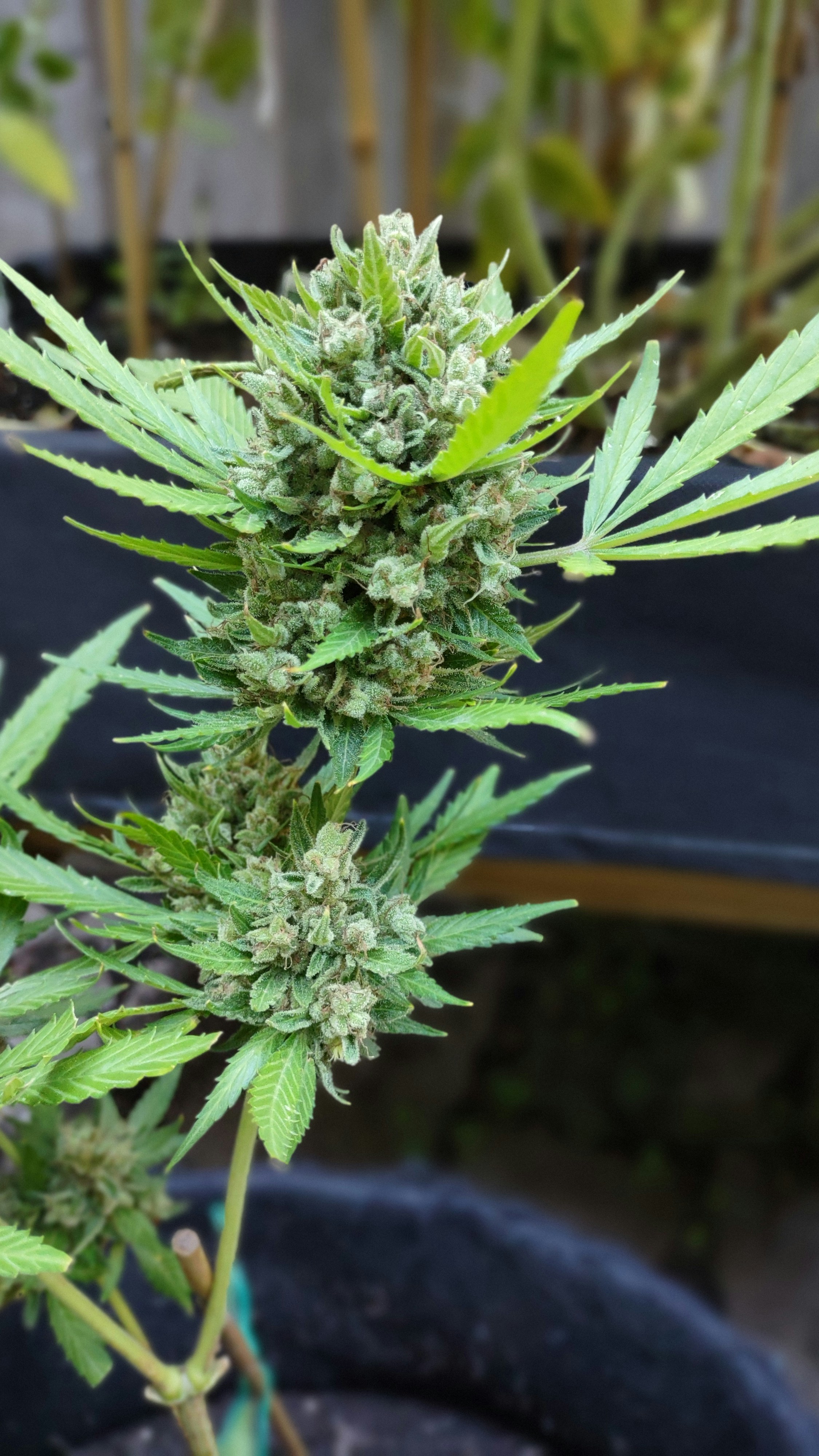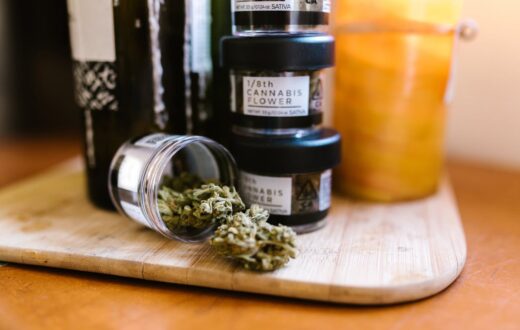Introduction to Critical Kush
The Critical Kush weed strain is a well-regarded hybrid that has garnered a significant following among cannabis enthusiasts and growers alike. Its origins can be traced back to a careful crossbreeding of the renowned Critical Mass and the potent OG Kush strains. The genetic lineage of Critical Kush combines the strengths of both parent strains, resulting in a well-balanced and highly desirable marijuana variety.
This strain is particularly popular due to its unique characteristics, which include a robust flavor profile that combines earthy notes with a subtle sweetness and hints of citrus. The aroma is just as appealing, with a pungent scent that features a blend of skunky and herbal undertones, enticing many to engage with its distinct fragrance. Critical Kush typically possesses high THC levels, making this strain potent and capable of offering substantial effects, which is one of the reasons it has become a favorite among not just casual users but also those seeking therapeutic benefits.
Growers appreciate Critical Kush not only for its quality effects but also for its relatively easy cultivation process. It is known to thrive in various environments, including indoor setups and outdoor gardens, where it can flourish in warm, sunny climates. Its resilience to common pests and molds also makes it suitable for novice cultivators. Additionally, the plant typically features dense, resinous buds, which are visually appealing and contribute to its overall desirability. Understanding how to grow Critical Kush weed strain effectively can lead to a successful and rewarding cultivation experience.
Why Choose Critical Kush for Cultivation
Growers seeking to cultivate cannabis often consider various factors that contribute to a strain’s overall appeal. Among the multitude of options available, Critical Kush stands out for several compelling reasons. First and foremost, its high-yield potential makes it an attractive choice for both novice and experienced cultivators. This strain is renowned for producing large quantities of dense, resinous buds, which can significantly increase the return on investment for growers, especially those operating on a commercial scale.
In addition to its impressive yields, Critical Kush is recognized for its robustness against common pests and diseases. Its resilient genetic makeup enables this strain to withstand various environmental stressors, allowing growers to cultivate it with less concern for crop losses. This resilience not only simplifies the growing process but also reduces dependence on chemical treatments, promoting a more organic cultivation approach. As a result, those interested in sustainable practices will find Critical Kush particularly appealing.
Another notable feature of Critical Kush is its faster flowering time compared to many other strains. Typically, growers can expect this strain to transition from the vegetative stage to full flowering within a relatively short period, often taking around 7 to 8 weeks. This prompt maturation allows cultivators to maximize their growing cycles, enabling them to produce multiple harvests throughout the year while also accommodating seasonal variations in their growing environment.
Lastly, the commercial viability of Critical Kush in the cannabis market should not be overlooked. Its combination of high yields, resistance to disease, and rapid flowering makes it a profitable option for growers looking to meet increasing consumer demand. With its solid reputation among connoisseurs and recreational users alike, prioritizing Critical Kush can offer significant advantages for successful cannabis cultivation.
Ideal Growing Conditions for Critical Kush
To achieve a successful harvest of the Critical Kush weed strain, growers must create and maintain optimal growing conditions. Whether cultivating indoors or outdoors, understanding temperature ranges, humidity levels, and lighting strategies is crucial. This strain thrives in a moderate climate, with ideal daytime temperatures ranging from 70°F to 80°F (21°C to 27°C). Nighttime temperatures should not drop below 60°F (15°C) to prevent stress on the plants.
Humidity plays a significant role in the development of Critical Kush. During the vegetative stage, relative humidity levels should be maintained between 40% and 70%. This facilitates healthy growth and robust root development. As the plants transition into the flowering stage, it is advisable to decrease humidity levels to around 40% or lower. This reduction discourages mold and mildew, which can threaten the overall health of the crop.
Lighting also significantly impacts the growth of Critical Kush. When grown indoors, utilizing high-quality LED or HID lights with an 18/6 light cycle during the vegetative phase is essential, transitioning to a 12/12 cycle during flowering. Good quality light will promote vigorous growth and resin production, ultimately enhancing the yield. For outdoor growers, ensuring that the plants receive ample sunlight is vital; Critical Kush thrives in full sun for most of the day.
Soil type is another factor that can influence the cultivation of this strain. It is recommended to use well-draining soil enriched with organic nutrients to support growth. Regular, balanced feeding with controlled-release fertilizers can boost plant health and yield. Lastly, establishing an appropriate watering schedule is paramount. Overwatering can lead to root rot, while underwatering may hinder plant growth. Regular monitoring of soil moisture will guide the watering process effectively.
By paying attention to these crucial environmental factors, growers can optimize their approach on how to grow Critical Kush weed strain, ensuring a bountiful and high-quality harvest.
Propagation Methods for Critical Kush
When it comes to cultivating the Critical Kush weed strain, growers have several propagation methods at their disposal. Choosing the right technique can significantly influence the plant’s growth and yield. Two primary propagation methods include seed germination and cloning.
Seed germination is the most common method for starting the Critical Kush strain. To begin, high-quality seeds are essential to ensure robust growth. The seeds should be soaked in water for 24 hours to initiate the germination process. Once they have absorbed moisture, they can be placed in a damp paper towel within a warm environment until the taproot emerges. This typically takes around 2-7 days, depending on conditions. Planting the germinated seeds in well-draining soil is crucial, as Critical Kush thrives in a nutrient-rich substrate. Proper care at this stage can lead to healthy plants in the flowering phase.
On the other hand, cloning is a popular method among experienced growers. By taking cuttings from a healthy mother plant, one can create multiple genetically identical plants. This approach allows for the preservation of desirable traits inherent to the Critical Kush strain. To successfully clone, ensure that the cuttings are taken from a healthy plant during its vegetative stage. The cuttings should be placed in a cloning gel or hormone to enhance root growth and then transferred to a suitable medium. While cloning can produce numerous plants quickly, it may sometimes result in weaker plants if not managed properly.
Each method has its advantages and disadvantages. Seed germination offers diversity and a cleaner start, while cloning provides consistency and ensures that specific traits are maintained. Regardless of the chosen method, best practices such as maintaining optimal moisture levels, proper lighting, and nutrient delivery will greatly enhance the likelihood of strong, healthy plants during the propagation stage.
Nutrient Needs and Feeding Schedule
When cultivating the Critical Kush weed strain, understanding its nutrient needs is paramount for achieving optimal growth and yield. The requirements will vary throughout the plant’s development stages, from seedling to vegetative and flowering phases. During the seedling stage, nurturing young plants requires a balanced fertilizer that is low in nitrogen, as excessive nitrogen can lead to nutrient burn. A nutrient solution designed for seedlings should include essential micronutrients like calcium and magnesium, which will help establish a robust foundation.
As the plants transition into the vegetative stage, their nutrient needs shift considerably. At this time, the focus should be on fostering lush, healthy foliage. Implementing a nitrogen-rich fertilizer with the appropriate levels of phosphorus and potassium will support vigorous growth. A general feeding schedule may involve applying nutrients every two weeks, ensuring that the mix is diluted to prevent overwhelming the plants. Additionally, incorporating organic compost or worm castings can improve soil health and nutrient retention.
During the flowering stage, the Critical Kush weed strain requires a different nutritional approach, where a phosphorus and potassium-rich formula becomes crucial. This shift in nutrient delivery will support the development of buds and enhance overall yield. A feeding schedule might entail transitioning to bloom-specific fertilizers that are lower in nitrogen, thereby fostering flower production. Keep a close watch on the plants for signs of nutrient deficiencies, which may manifest as yellowing leaves or abnormal growth patterns. Adjusting the feeding plan quickly can mitigate potential issues and ensure plants thrive. Monitoring the pH levels of the nutrient solution and soil can further aid in maintaining optimal conditions for nutrient absorption, thus enhancing the growth of Critical Kush weed strain.
Pest and Disease Management
Managing pests and diseases is a crucial aspect of growing the Critical Kush weed strain successfully. This strain is known for its resilience, but it is not immune to common horticultural adversaries. A proactive approach to prevention can significantly reduce the likelihood of infestations and diseases disrupting your cultivation efforts.
Common pests that affect the Critical Kush strain include spider mites, aphids, and whiteflies. These pests can quickly multiply and cause significant damage to your plants. Regularly inspecting your crops for signs of these pests is essential. Look for discolored leaves, webbing, or sticky residue, which can indicate an infestation. To prevent these pests, consider using barriers such as insect netting, maintaining cleanliness in your growing area, and introducing beneficial insects, like ladybugs, which can naturally control pest populations.
In addition to pests, various diseases such as powdery mildew and root rot can threaten your Critical Kush crop. Powdery mildew thrives in environments with high humidity, making proper ventilation and air circulation imperative. If you notice a white, powdery substance on your leaves, it is vital to act quickly by increasing airflow and applying organic treatments like neem oil or a baking soda solution. Root rot often results from overwatering, so it is essential to monitor your watering schedule and ensure your soil has adequate drainage.
When organic treatments do not yield results, you may need to use more aggressive methods. This could involve targeted insecticides or fungicides designed for cannabis cultivation. Always follow the recommended application rates and timing to avoid harming beneficial organisms and to maintain the integrity of your Critical Kush strain. By implementing effective pest and disease management strategies, you can ensure a healthy and thriving crop.
Harvesting Critical Kush: Signs and Best Practices
The process of harvesting Critical Kush weed strain is a crucial stage that can significantly impact both yield and quality. Proper timing and techniques are essential to achieve optimal results. The visual indicators that signify readiness for harvesting include trichome development and the color of the pistils. When examining the trichomes, a magnifying glass or jeweler’s loupe is recommended. Clear trichomes indicate that the plant is still maturing, while milky or cloudy trichomes suggest that the peak potency is approaching. A hint of amber coloration in the trichomes signals that the THC content has begun to degrade, leading to a more relaxing effect. Generally, a balance of cloudy and amber trichomes is sought by growers for ideal potency.
Additionally, the condition of the pistils can provide further insights into readiness for harvesting. During the flowering phase of the Critical Kush strain, pistils start off white and eventually transition to a darker color, typically orange or brown, as maturity approaches. When approximately 70-80% of the pistils have changed color, it is an indication that the plant is nearing completion. Observing these changes will help ensure that Critical Kush is harvested at the right time, thus preserving its unique flavor and potency.
Best practices for harvesting include selecting the right time of day, ideally in the early morning when the humidity is still present. This can help in preserving the flavor and aroma of the buds. Using clean and sharp tools reduces the risk of damaging the plants during the harvest process. Cut the branches carefully and avoid excessive handling to maintain the integrity of the buds. Following these techniques will enhance the quality of the harvested Critical Kush, ensuring that the time and effort put into cultivation yield rewarding results.
Post-Harvest Processing and Curing
Once the Critical Kush weed strain has been harvested, the subsequent steps are vital to ensure that the product meets quality standards in terms of flavor, potency, and overall appeal. The post-harvest processing begins with drying, a crucial method that helps to reduce moisture content in the buds, thereby preventing mold and degradation. Ideally, the drying process should take place in a controlled environment with low humidity and stable temperatures, typically around 60-70 degrees Fahrenheit (15-21 degrees Celsius). Storing the harvested buds in dark conditions also aids in preserving their potency and preventing light degradation.
Humidity control is paramount during this phase; aim for a humidity level of about 50-60%. This can be achieved by using hygrometers to monitor moisture levels in the drying area. After approximately 5 to 10 days of drying, the buds should be crisp on the outside yet pliable on the inside. To test their readiness, gently squeeze a bud; if it springs back to shape, it is ready for the next step.
Curing further enhances the characteristics of the Critical Kush strain. This involves transferring the dried buds into glass jars or airtight containers, filling them about three-quarters full to allow for air circulation. During the curing process, it’s essential to regularly open the jars (known as burping) for the first few weeks to release built-up moisture and replenish oxygen, ideally in a dark, cool place. This not only improves the flavor profile but also elevates the smell and potency of the buds.
For optimal storage after curing, keep the glass jars in a cool, dark space, ensuring temperature fluctuations are minimal. Ideal storage conditions will help maintain both quality and freshness over time, allowing consumers to enjoy the full benefits of their Critical Kush weed strain long after the harvest.
Conclusion: The Rewards of Growing Critical Kush
In the realm of cannabis cultivation, learning how to grow Critical Kush weed strain can lead to a deeply rewarding experience for both novice and seasoned growers alike. As highlighted throughout this article, this strain is known for its impressive yield, robust growth patterns, and delightful flavors, making it a favorite among enthusiasts. By following the cultivation guidelines, including optimizing light exposure, maintaining proper humidity levels, and ensuring nutrient-rich soil, one can create an ideal environment for Critical Kush to thrive.
The flowering phase of Critical Kush is particularly striking, typically resulting in dense, resinous buds that are not only visually appealing but also potent in effects. The potential for high THC content serves to amplify the satisfaction of cultivating this strain, providing users with a powerful and enjoyable cannabis experience. This dual appeal—both in terms of cultivation and consumption—makes the strain a rewarding choice for growers intent on enhancing their gardening skills.
Moreover, the versatility of Critical Kush means it can be grown both indoors and outdoors, accommodating a variety of cultivation preferences and environments. As you gain familiarity with the growth patterns and needs of this strain, it is possible to experiment with different growing techniques, leading to personal innovation in cultivating not just Critical Kush, but other strains as well.
Ultimately, the journey of mastering how to grow Critical Kush weed strain is one of personal development, patience, and gratification. Each grow cycle provides valuable lessons, enhancing your skills and paving the way for future successes. Embrace the process and relish the rewards, both tangible and intangible, that arise from nurturing this exceptional strain, and you will find yourself reaping the benefits, time and again.













